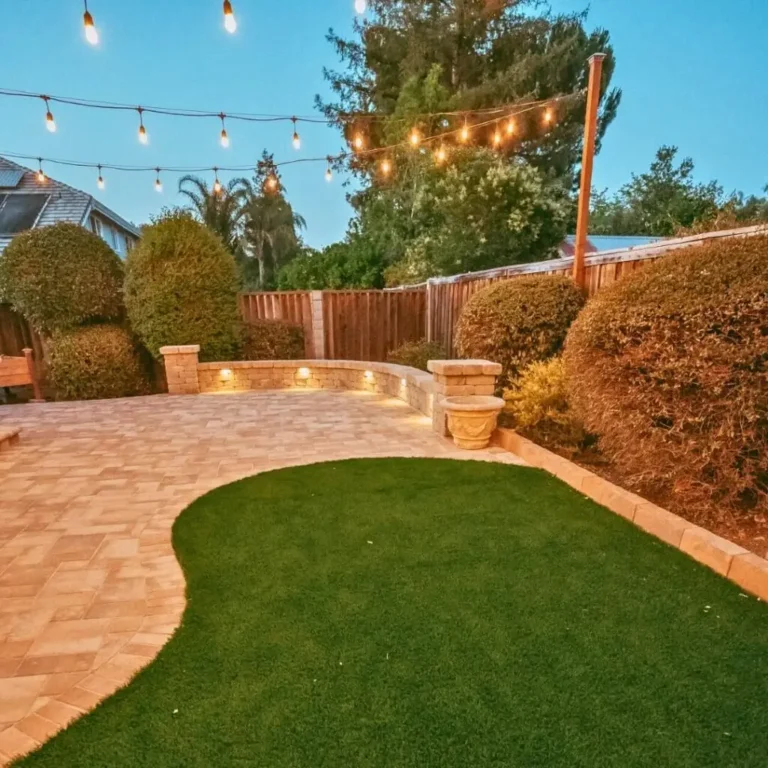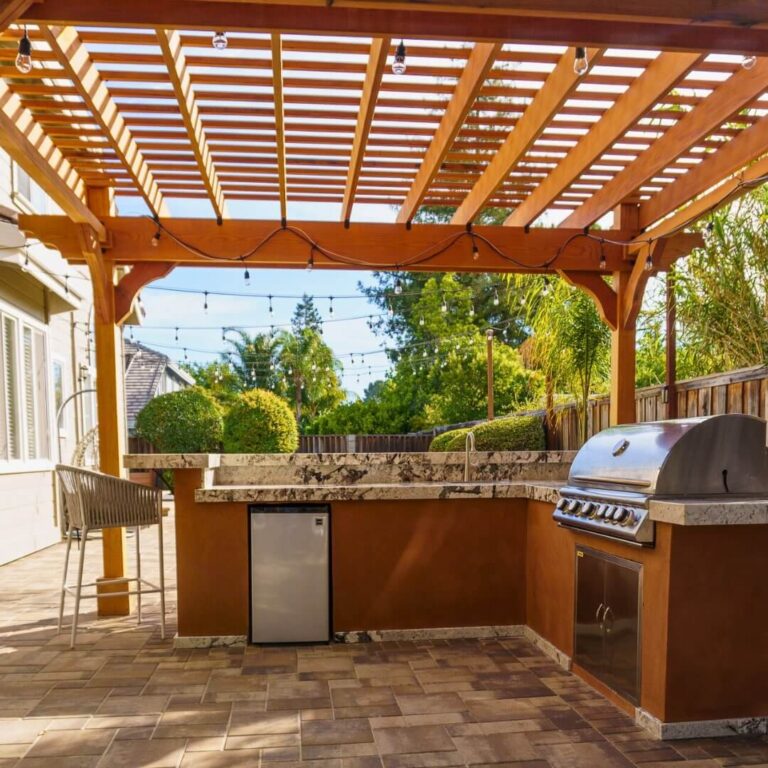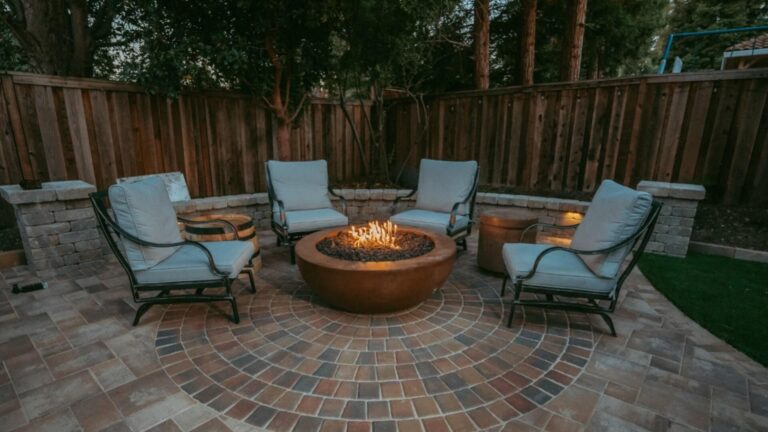How to Fix a Muddy Backyard: Simple Solutions for a Cleaner Outdoor Space

A muddy backyard can be a frustrating problem for homeowners, especially during the rainy season. It can make it difficult to enjoy outdoor activities and can even cause damage to your property. Fortunately, there are several solutions to fix a muddy backyard and create a beautiful, functional outdoor space.
One option is to install pavers. Pavers come in a variety of materials, such as concrete, brick, and natural stone, and can be arranged in different patterns to create a unique look. They are also durable and can withstand heavy foot traffic and harsh weather conditions. Installing pavers can help to create a stable surface that will prevent mud from forming and give your backyard a polished appearance.
Another solution is to incorporate landscaping and hardscaping elements into your backyard design. This can include adding plants, trees, and shrubs to absorb excess water and create a natural barrier against erosion. Hardscaping features, such as retaining walls and drainage systems, can also help to redirect water away from your backyard and prevent mud from forming. By combining these elements, you can create an aesthetically pleasing and functional backyard that will stand up to the elements.
Related Posts:
Understanding Your Yard
Before attempting to fix a muddy backyard, it is essential to understand the underlying causes of the problem. The first step to understanding your yard is to assess the soil type and condition. Different types of soil have different drainage capabilities, which can affect how quickly water is absorbed or drained from the surface.
Soil erosion is another factor that can contribute to a muddy backyard. Heavy rainfall or improper drainage can cause soil to wash away, leaving behind bare patches or muddy areas. Soil compaction is another common issue that can cause poor drainage and lead to a muddy yard. Compacted soil is dense and hard, making it difficult for water to penetrate the surface.
To determine if soil compaction is an issue, homeowners can perform a simple test. They can use a garden fork or soil probe to see how easily the soil is penetrated. If the soil is hard and difficult to penetrate, it may be compacted.
Once the soil condition has been assessed, homeowners can take steps to improve drainage and prevent soil erosion. This may include adding organic matter to the soil, aerating the lawn, or installing a drainage system.
Overall, understanding the soil type, condition, erosion, and compaction of your yard is crucial in fixing a muddy backyard. By addressing these underlying issues, homeowners can create a healthy and functional outdoor space that is free from mud and standing water.
Dealing With Drainage
When it comes to fixing a muddy backyard, dealing with drainage is one of the most important steps. Poor drainage can cause water to accumulate in your backyard, leading to muddy and swampy conditions.
One common solution to drainage problems is to install a French drain. A French drain is a trench filled with gravel or rock that redirects water away from the problem area. The trench is typically lined with a permeable fabric to prevent soil from clogging the drain.
Another option is to install a drainage system with pipes. This involves digging trenches and laying pipes to redirect water away from the problem area. The pipes can be connected to a sump pump or a drainage ditch to carry the water away from your backyard.
Before installing any drainage system, it is important to identify the source of the problem. Is the water coming from a nearby slope or is it due to poor soil drainage? Once the source of the problem is identified, the appropriate drainage solution can be implemented.
It is also important to regularly maintain your drainage system to ensure it continues to function properly. This includes cleaning out any debris that may have accumulated in the pipes or French drain, and checking for any signs of damage or clogs.
By dealing with drainage problems in your backyard, you can prevent muddy and swampy conditions, and create a more enjoyable outdoor space.
Choosing Ground Cover
When it comes to fixing a muddy backyard, choosing the right ground cover can make all the difference. Here are some options to consider:
- Mulch: Mulch is a great option for areas that don’t get a lot of foot traffic. It helps retain moisture and can add nutrients to the soil as it breaks down. However, it can be messy and may need to be replenished periodically.
- Grass: Grass is a popular option for many homeowners, as it provides a natural look and can withstand foot traffic. However, it requires regular maintenance, such as mowing and watering, and may not be suitable for shady areas.
- Rock: Rock is a low-maintenance option that can add texture and visual interest to a backyard. It’s also great for areas that get a lot of foot traffic. However, it can be expensive and may not be the most comfortable option for sitting or playing.
- Sand: Sand is a good option for areas that are prone to flooding or have poor drainage. It’s also great for creating a beachy vibe. However, it can be difficult to keep in place and may require periodic replenishment.
No matter which option you choose, be sure to consider factors such as cost, maintenance, and aesthetic appeal. With the right ground cover, you can turn a muddy backyard into a beautiful outdoor space.
Implementing Hardscaping
Hardscaping is an effective way to transform a muddy backyard into a functional and visually appealing outdoor space. This involves the use of hard materials such as pavers, concrete, stones, and patios to create a solid surface that can withstand heavy foot traffic and adverse weather conditions.
One of the most popular hardscaping options is the use of pavers. These interlocking stones come in a variety of shapes, sizes, and colors, making them a versatile choice for any backyard design. They are also easy to install, with the right tools and techniques, and can be used to create walkways, driveways, and even outdoor living areas.
Another great option for hardscaping is concrete. This material is durable and long-lasting, making it ideal for high-traffic areas. It can be poured into any shape or size, allowing for endless design possibilities. Concrete can also be stamped or stained to mimic the look of natural stone or brick, giving your backyard a unique and personalized touch.
Stones are another popular choice for hardscaping. They come in a range of colors and textures, and can be used to create everything from a simple garden path to an elaborate outdoor living space. Stones are also low-maintenance and can withstand harsh weather conditions, making them a great investment for any backyard.
Finally, a gazebo is a great addition to any backyard hardscaping project. It provides a covered outdoor space for entertaining, relaxing, or dining, and can be customized to fit any style or design. A gazebo can also add value to your home, making it a smart investment for any homeowner.
Related Posts:
- How to Install Pavers: A Complete Guide
- BBP Pavers Pool Decks: Premium Paver Installation
- Patio Pavers: Bay Area Paver Installation | Get a Quote!
Improving Soil Conditions
Improving soil conditions is crucial to fixing a muddy backyard. Here are some ways to improve soil conditions:
Adding Compost
Compost is a great way to add organic matter to the soil, which can improve the soil’s structure and drainage. It also helps to add nutrients to the soil, which can help plants grow. Spread a layer of compost over the soil and mix it in with a garden fork or tiller.
Adding Organic Matter
Adding organic matter to the soil can help to improve soil structure and drainage. Organic matter can be added in the form of compost, manure, or leaf mold. Spread a layer of organic matter over the soil and mix it in with a garden fork or tiller.
Adding Lime
If the soil is too acidic, adding lime can help to raise the pH level and improve soil structure. It is important to test the soil’s pH level before adding lime, as too much lime can be harmful to plants. Follow the instructions on the lime package carefully.
Adding Peat Moss
Peat moss is a great way to improve soil structure and drainage. It also helps to retain moisture in the soil. Spread a layer of peat moss over the soil and mix it in with a garden fork or tiller.
Improving Soil
Improving soil can take time, but it is worth the effort. By adding compost, organic matter, lime, and peat moss, the soil can be improved and the backyard can become less muddy. It is important to test the soil and follow instructions carefully when adding any amendments.
Maintaining Your Yard
Once you have fixed the muddy areas in your backyard, it’s important to maintain your yard to prevent it from becoming muddy again. Here are some tips to keep your yard healthy and mud-free:
Lawn Maintenance
Regular lawn maintenance is essential to keep your yard healthy. Mowing your lawn at the right height and frequency can help prevent soil compaction and promote healthy root growth. It’s recommended to mow your lawn to a height of 2-3 inches and to never remove more than one-third of the grass blade at a time.
Aerate
Aerating your lawn can help improve soil drainage and reduce soil compaction. This process involves creating small holes in the soil to allow air, water, and nutrients to penetrate the soil and reach the roots of your grass. It’s recommended to aerate your lawn once a year, preferably in the fall.
Dethatch
Thatch is a layer of dead grass and other organic material that accumulates on the surface of the soil. Too much thatch can prevent water and nutrients from reaching the roots of your grass, leading to a muddy and unhealthy lawn. Dethatching involves removing this layer of thatch to promote healthy grass growth. It’s recommended to dethatch your lawn every 2-3 years.
Overseeding/Reseed
Overseeding or reseeding your lawn can help fill in bare spots and promote healthy grass growth. It’s recommended to overseed your lawn in the fall when soil temperatures are still warm enough for germination, but cool enough to prevent stress on the grass. Make sure to choose the right type of grass seed for your climate and soil conditions.
By following these tips, you can maintain a healthy and mud-free yard. Remember to always water your lawn deeply and infrequently, and to avoid walking on your lawn when it’s wet to prevent soil compaction.
Dealing With Muddy Areas
Muddy areas in a backyard can be a real pain, especially after heavy rainfall or snowmelt. Fortunately, there are several ways to deal with these muddy spots and prevent them from becoming a muddy mess.
Here are a few tips to help you fix a muddy backyard:
1. Add Organic Matter
One of the simplest ways to fix a muddy yard is by adding organic matter such as compost, leaf mold, or straw. Organic matter helps to improve soil structure, increase water retention, and promote healthy plant growth. Spread a layer of organic matter over the muddy spots and work it into the soil using a garden fork or tiller.
2. Install Drainage
If you have a persistent muddy patch in your backyard, it may be due to poor drainage. Installing a drainage system can help to redirect excess water away from your yard and prevent muddy areas from forming. A French drain or a dry well are two popular options for backyard drainage.
3. Use Gravel or Mulch
Gravel or mulch can also be used to fix a muddy backyard. These materials help to improve drainage and provide a stable surface for walking or playing on. Spread a layer of gravel or mulch over the muddy spots to create a stable and attractive surface.
4. Plant Grass or Ground Cover
Planting grass or ground cover can also help to fix a muddy backyard. Grass and ground cover help to stabilize the soil and absorb excess water. Choose grass or ground cover that is suitable for your climate and soil type.
By following these tips, you can fix a muddy backyard and prevent muddy spots from forming in the future.
Conclusion
Fixing a muddy backyard can be a challenging task, but with the right tools and techniques, it is possible to transform your outdoor space into a beautiful and functional area. Whether you are interested in gardening, landscape design, or just want to improve the aesthetic appeal of your backyard, there are a few key things to keep in mind.
First, it is important to consider the weather in your area. If you live in a region with heavy rainfall or frequent storms, you may need to take extra steps to ensure that your backyard stays dry and free from mud. This could include installing drainage systems, using permeable materials for walkways and patios, or planting water-loving plants that can absorb excess moisture.
Another important factor to consider is the needs of your pets. If you have active dogs that love to play in the backyard, you may need to create designated play areas that are covered in artificial turf or other durable materials. This can help prevent mud from forming and also provide a safe and comfortable surface for your pets to enjoy.
When it comes to landscape design, there are many options to choose from. Consider adding raised beds or container gardens to your backyard to create a beautiful and functional space for growing vegetables, herbs, and flowers. You could also incorporate features like fountains, statues, or decorative rocks to add visual interest and texture to your outdoor space.
Overall, fixing a muddy backyard requires a combination of planning, creativity, and hard work. By following the tips and techniques outlined in this article, you can transform your backyard into a beautiful and functional space that you and your family can enjoy for years to come.
Frequently Asked Questions
How can I improve drainage in my backyard?
Improving drainage in your backyard can help reduce muddy areas. You can start by grading the landscape to ensure that water flows away from your house and towards a drainage area. You can also install a French drain or a dry well to collect excess water. Another option is to create a rain garden to absorb excess water.
How do I create a rain garden to reduce muddy areas?
A rain garden is a shallow depression in your yard that is planted with native plants and grasses that can absorb excess water. To create a rain garden, you should first identify a low-lying area in your yard that collects water. Next, excavate the area and add a layer of gravel for drainage. Finally, fill the area with a mix of soil and compost and plant your rain garden with native plants.
What type of grass is best for a muddy backyard?
Grass that is tolerant to wet conditions is best for a muddy backyard. Some good options include Kentucky bluegrass, perennial ryegrass, and tall fescue. However, it’s important to note that no grass is completely immune to muddy conditions.
Can adding compost or topsoil help fix a muddy backyard?
Adding compost or topsoil can help improve the soil structure and drainage in a muddy backyard. However, it’s important to ensure that you don’t add too much as this can lead to other problems such as nutrient imbalances.
How do I prevent mud from forming in high traffic areas of my yard?
Preventing mud in high traffic areas can be challenging but there are some solutions. You can install a walkway or stepping stones to direct traffic away from these areas. You can also consider using a ground cover such as mulch or wood chips to reduce soil erosion.
Are there any plants or shrubs that can absorb excess water in a muddy backyard?
Yes, there are many plants and shrubs that can absorb excess water in a muddy backyard. Some good options include willows, dogwoods, and red twig dogwoods. These plants can also add aesthetic value to your yard.






